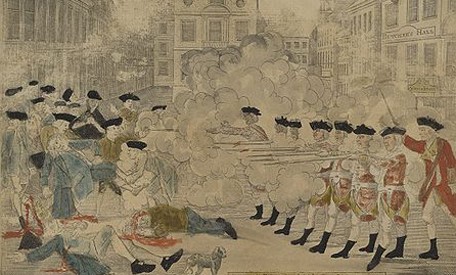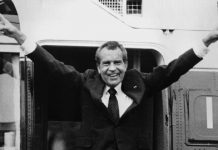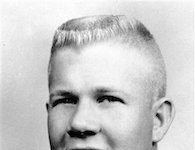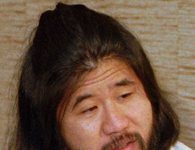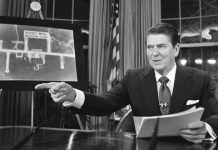On March 5, 1770, British soldiers stationed in Boston fired on a crowd of hecklers, killing five and wounding others.
British Soldiers Open Fire on Mob
British soldiers had been stationed in Boston since October 1768, when they were sent to enforce the Townshend Acts of 1767. The colonists saw the soldiers as invaders, causing hostility and frequent skirmishes.
The Boston Massacre began on a cold March night as a small dispute between British sentry Hugh White and a wig-maker’s apprentice who claimed that a soldier had not paid for a wig. White struck the boy with his musket, prompting a group of men and boys to mob the soldiers, taunting them and throwing stones, ice and other objects.
As the crowd around White became larger and increasingly violent, other skirmishes broke out nearby. Captain Thomas Preston marched his men from the Main Guard to White’s aid, forming a tight semi-circle around him, as the crowd continued to pelt the soldiers. One colonist, possibly a mulatto sailor named Crispus Attucks, knocked down soldier Hugh Montgomery.
Montgomery rose, fired his musket into the crowd and shouted, “Damn you, fire!” The other soldiers, despite orders from Preston not to fire, did so. Attucks was struck with two bullets in the chest and was the first of three to die that night. A fourth died the following morning and a fifth two weeks later. About another half-dozen were wounded.
Witness Accounts of the Massacre
History Matters provides the witness account of George Robert Twelve Hewes, a Boston shoemaker.
EyeWitness to History provides Captain Preston’s account.
Sources in this Story
- University of Missouri-Kansas City School of Law: The Boston Massacre Trial of 1770
- American Heritage: Verdicts of History I: The Boston Massacre
- Digital History: Short Narrative of the Horrid Massacre in Boston
- Library of Congress: The Boston Massacre
- Archiving Early America: Boston Massacre: A Behind-the-Scenes Look At Paul Revere’s Most Famous Engraving
Trials of the Soldiers
Captain Preston and eight of his men were arrested and indicted. Thomas Hutchinson, governor of colonial Massachusetts, asked prominent lawyer John Adams, a future president of the United States, to defend the soldiers. Though Adams supported liberty for the colony and knew that defending the British would be an unpopular decision, he believed that the soldiers deserved a fair trial and accepted the case.
Preston’s trial began in October. Adams objected to every potential juror from Boston and was able to fill the jury entirely with men from outside the city. During the trial, the main issue was whether Preston gave the order to fire.
The prosecution called many witnesses who claimed that Preston gave the order, but Adams called Richard Palmes, a pro-liberty merchant who had given a deposition saying that the soldiers fired without an order from Preston. His testimony swayed the trial in Preston’s favor and the jury acquitted him of all charges.
The trial of the soldiers began eight weeks later. It focused on whether the soldiers acted in self-defense, as witnesses gave contradictory accounts on the level of hostility exhibited by the crowd. The jury acquitted six of the soldiers, but found Montgomery and Matthew Killroy guilty of manslaughter.
Adams appealed for the benefit of clergy, a provision that allowed literate defendants to receive lesser sentences. After reading a passage of the Bible to prove their literacy, the two men had their thumbs branded, but received no prison time.
The Boston Massacre as Propaganda
American patriots used the Boston Massacre to intensify anti-British sentiment in the colony and grow support for their movement. Samuel Adams, cousin of John Adams and leader of the Sons of Liberty, published unabashedly biased accounts of the incident in the Boston Gazette, including “A Short Narrative of the Horrid Massacre in Boston.” He also released a book of 96 eyewitness accounts, all but one of which had a distinctly anti-British slant.
Paul Revere sold color prints of the incident depicting a line of British soldiers firing into a peaceful crowd. “His historic engraving is long on political propaganda and short on accuracy or aesthetics,” says the Library of Congress.
“Few historians would deny that the ‘Boston Massacre’ proved to be a milestone in America’s road to independence,” writes Archiving Early America. “By popularizing the tragic event, Paul Revere’s print became ‘the first powerful influence in forming an outspoken anti-British public opinion,’ one which the revolutionary leaders had almost lost hope of achieving.”
Historical Context: The Revolutionary War
The findingDulcinea Web Guide to the American Revolution links to the most comprehensive and reliable sources on the war.
American Revolution Events
- 1773: Boston Tea Party
- 1775: Patrick Henry’s Liberty or Death Speech
- 1775: Paul Revere’s Midnight Ride
- 1776: Declaration of Independence
- 1783: Treaty of Paris
Key Player: John Adams
John Adams was one of the leaders of the American Revolution, advocating for independence at the Continental Congresses and serving as a diplomat in Britain during the Revolutionary War. He also served as George Washington’s vice president and as the second president of the United States from 1797 to 1801.


